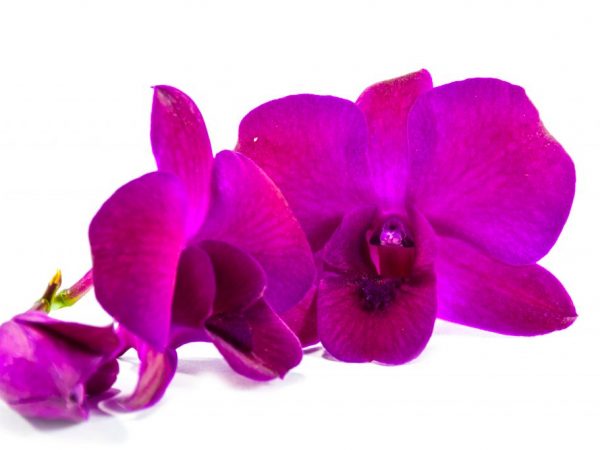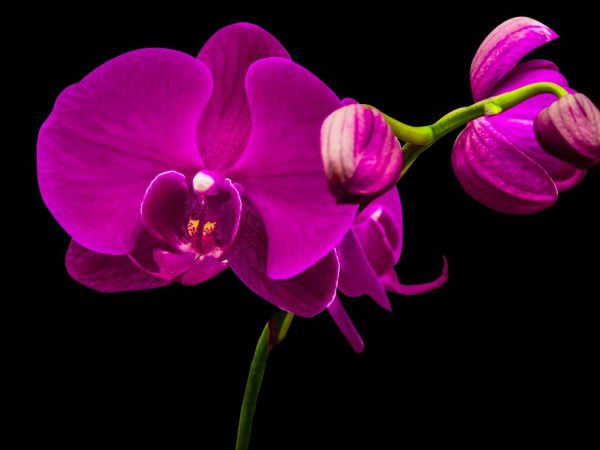Growing Dendrobium Phalaenopsis
Dendrobium Phalaenopsis is one of the orchid varieties. The plant is often grown for sale and indoor decor. During cultivation, sometimes difficulties arise associated with long flowering and development, which is why it is so important to know how to care for the Dendrobium Phalaenopsis orchid at home.

Growing Dendrobium Phalaenopsis
Plant characteristic
The Dendrobium Phalaenopsis orchid is a perennial plant with sympodial growth qualities. It has a large number of branches that grow densely from the roots. Abundant flowering, with a duration of 3-4 months. During this time, straight peduncles form on the top of the plant. They have from 5 to 40 flowers. The flowers themselves have 8 petals. Their colors are white, pink, yellow and purple.
The orchid variety Dendrobium Phalaenopsis has a number of advantages:
- long flowering period;
- beautiful flowers with a pleasant smell;
- unpretentious care.
There is also a minus: old shoots die off for a long time, which spoils the appearance of the orchid.
Growing a flower
Dendrobium Phalaenopsis is grown by seeds and seedlings. Each method has its own pros and cons.
Planting seedlings
In indoor conditions, it is advisable to choose planting seedlings on a block so that the root system does not start to rot. When choosing a pot, take into account the massiveness of the orchid. Large flowers, after the substrate dries, fall out of light containers, for example, from plastic ones, so it is recommended to use clay pots.
A mixture of coniferous bark and coal is taken as a substrate, sometimes coconut chips are added. Perlite or pieces of styrofoam will do. These elements increase the permeability of air to the substrate. If the moisture level in the room is low, moss is added to the substrate to increase the moisture holding capacity.
Growing an orchid from seed
Dendrobium has small seeds. They resemble dust in appearance. If you sow them in natural conditions, there is practically no chance that they will take root and sprout, so the flower releases up to a million seeds per season. They all lack nutrients. In order for the embryo to begin to ripen, it is infected with a fungus that creates mycorrhiza. It grows inside the embryo, creates a seedling with water and all important minerals.
Growing Dendrobium Phalaenopsis at home causes a number of problems:
- seeds are easily infected with diseases;
- for growing, it is necessary to create sterile conditions that are difficult to obtain in an apartment;
- the formation of seedlings is delayed for 9 months.
Planting containers

An orchid does not need a large pot
A pot for planting a small tree in a room environment is usually taken from a plastic one. When the plant grows up, it is transplanted into a sturdier clay container.The size of the container should be from 10 cm to 15 cm. They are based on the parameters of the flower itself. The inside should be 3-4 cm larger than the orchid itself. When planting, the flower is set so that the side of the pseudobulb growth is near the center.
Planting soil
Dendrobium Phalaenopsis loves loose soil rich in nutrients. For the soil substrate, a mixture based on pine bark, peat and moss is used. It is advisable to add charcoal to it. Calcium should not be in the ground, since the orchid does not react well to it. The prepared soil must be disinfected. To do this, it is poured over with hot water and allowed to infuse for 10-15 minutes. Then the earth is allowed to dry, only then the plant is planted. A thick layer of sphagnum is placed on the bottom of the container or supports are installed.
Orchid care indoors
Dendrobium Phalaenopsis is undemanding to care for, however, it is important to observe some features for good growth. Flower care is as follows:
- lighting;
- watering;
- treatment and prevention of diseases;
- temperature;
- air humidity;
- transplanting and pruning;
- fertilization.
Lighting
Dendrobium Phalaenopsis does not tolerate direct sunlight. A suitable place for development is the southeast side of the premises. The flower grower has the opportunity to see where the plant will feel good, and where it is bad, by placing the flower on different windowsills of the house. In winter, there is not enough light for full development - the orchid slows down in growth. In such cases, artificial lighting is used.
Temperature
A special feature is the temperature regime during the development of Dendrobium Phalaenopsis, therefore it is important to control it. The flower quickly gets used to any temperature, but 16 ° C-32 ° C is considered optimal. The plant loves warmth and dies at a temperature of 10 ° C-12 ° C.
Watering
An important feature when caring for a flower is watering. If it is hot in the room where the plant lives, the amount of watering is increased. The water should be soft and warm. A hot shower is recommended.
After watering, make sure that the water does not accumulate in the pan, but dries out. To determine whether it is worth watering the flower, the stick is placed in a container with earth. If it is dry, watering is carried out.
Fertilization
During the period of vigorous development, from April to September, Dendrobium Phalaenopsis is fed. They are fed 2 times a month. For this, complex fertilizers are used specifically for orchids.
A strong concentration of mixtures leaves burns on the root system - the proportion is made 2 times less than what is written in the instructions. In winter, the flower is fertilized with phosphorus-potassium substances.
Air humidity

The flower does not tolerate dryness
The orchid suffices from 50-55% moisture. If the room where the flower lives is dry, use a household air humidifier to create the necessary conditions or place the pot on a pallet with expanded clay and put a cup of water next to it.
Pruning
The flower of this variety does not need pruning. You cannot remove flower stalks, new and old shoots on your own: they contain a large supply of nutrients that help the tree to develop and bloom correctly.
Transfer
Flowers are bad for transplanting, so it is carried out no more than once every 2-3 years and at the beginning of the growing season. The pick is carried out carefully, since the peduncles may be damaged, due to which the plant dies. For transplanting Dendrobium Phalaenopsis, they use land intended for orchids. Pine bark, peat, coal and sphagnum are added to the soil. Drainage is installed at the bottom of the container. The pot for transplanting is made of ceramic or plastic, but not transparent. It should be tall and fit.
Diseases and pests
Diseases
The flower begins to ache when there is a violation of care.
- Fusarium appears due to excess water. The disease destroys the root system, then the flower dies. It is impossible to cure it.
- Hives appear on the leaves as large spots. The cause of the onset of the disease is the wrong temperature and humidity. For treatment, the conditions for care are fulfilled.
- Botrytis appears as dark spots on the foliage, after which they begin to fade. Poor ventilation is the cause.
Often there are non-infectious diseases that develop due to improper watering and temperature conditions.
Pests
- Mealy worms. These are insects that are easy to spot. The leaves turn yellow and fall off. For treatment, a soap solution is prepared, with which the plant is wiped.
- Spider mite. It forms traces of a silvery cobweb on the foliage. To cope with insects will be possible with soapy water or Acaricide.
- Thrips. Because of them, brown spots are formed. You can destroy parasites with Actellik.
- Thyroid gland. Bumps form on the foliage. A soap solution is used for treatment.
- Slugs. Insects are eating a flower. Remove them under the power of the prepared substrate from a cucumber or carrot. When a slug crawls onto a vegetable, it is removed.
Preventive actions
The flower of this variety rarely gets sick, unlike other species, but it will not hurt to follow preventive measures. The owner should inspect the flower every day and keep it separate from other plants for some time, control the temperature and moisture in the room. Observe the amount of water when watering in order to prevent the death of the roots.
Conclusion
The flower pleases with beauty and gives comfort to any room, the main thing is to take proper care of it.


